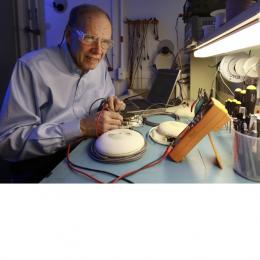UT-Battelle Awards Night - 2016 Technology Transfer Award

The Smart Smoke Alarm detects real fires faster and more reliably than existing residential smoke alarms while reducing or eliminating false alarms. The widespread use of smoke alarms in homes has cut in half the annual number of home fire deaths since 1975. As significant an achievement as this has been for the nation, modern furnishings spread fires more quickly and release toxic vapors, dramatically lowering safe exit times and increasing the need for fast and accurate alarming. Another big problem is that people often disable their alarms because of false alarms or “nuisance alarms” – and in fact – most alarms are nuisance alarms (e.g., associated with cooking and showering). A study by Hughes in 2014 estimates that as many as 1235 deaths per year could be avoided by eliminating nuisance alarms. The Smart Smoke Alarm recognizes the difference between “fire,” “nuisance,” or “normal” conditions and responds immediately as needed to alert home residents or simply to stay silent even when the toaster is on.
With funding and support by the U.S. Fire Administration and the Consumer Product Safety Commission, ORNL researchers Bruce Warmack, Steven Shane Frank, and Dennis Wolf employed statistical techniques used in advanced chemical detectors that allow data from multiple one or more smoke, temperature and carbon monoxide (CO) sensors to be classified for rapid alarming. Training data from real fire scenarios are used with a mathematical technique called linear discriminant analysis (LDA) to allow inexpensive microcontrollers found in ordinary smoke alarms to recognize real hazards while rejecting conditions that would trigger false alarms in conventional smoke alarms. Ordinary sensors found in existing smoke alarms are more fully employed without significant additional expense, making the technology affordable for all. This technology is protected in U.S. Patents No. 9,019,109 and 9,171,453.
ORNL advanced this invention under the Technology Innovation Program (TIP), wherein a small amount of seed-money is provided to benchmark and improve the invention's readiness levels. Using the additional funding provided by TIP, the inventors collaborated and tested their detector at UL under variety of fire conditions, further perfecting and demonstrating the algorithms. The technology was then marketed at SupDet 2014 (technical), Spark (entrepreneurial), and NFPA Expo (user) as well as via direct mailing and contact with a number of major alarm manufacturers by the inventors and commercialization manager.
The marketing campaign resulted in licensing negotiation by Dr. Eugene Cochran and Mr. Marc Filigenzi with a major manufacturer. ORNL then collaborated by supplying prototype units. The Partnerships Directorate at ORNL appreciates that this agreement may be one of the national lab’s more significant connections to enable widespread utilization and to affect residential wellbeing and safety. “We are glad to see this agreement culminate because it provides a great channel for ORNL technology to work its way into common consumer products,” says Mike Paulus.
The UT-Battelle Awards Night honorees were recognized at a special event on November 18, 2016.

